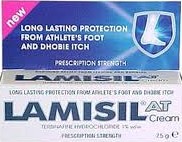Terbinafine Side effects
Terbinafine is an antifungal medication. It is a synthetic allylamine medication that is highly lipophilic or binds to lipids. It accumulates in the fatty tissues, nails and skin where fungus are usually found. Terbinafine works by stopping the growth of the fungus by altering its cell membrane synthesis leading to lysis of the fungus. Despite its beneficial effects in inhibiting fungi, it may also produce terbinafine side-effects along with any other medication that may yield various side-effects and adverse reactions. Terbinafine hydrochloride is the specific active component of the drug and it is sold in the brand names Lamisil, Corbinal, Terbisil and Zabel.
Terbinafine is available in oral and topical preparations. All of these preparations have the potential to produce terbinafine side effects. Indications of terbinafine include:
- Tinea Cruris or jock itch
- Tiea pedis or athlete’s foot
- Tinea corporis or ring worm
- Tinea capitis or ringworm of the scalp in children
- Onychomycosis of the finger nails and toe nail
- Other forms of fungal infections caused by dermatophytes
Side effects of Terbinafine
There have been a lot of terbinafine side effects that have been reported. These terbinafine side effects may be induced by its extensive biodistribution meaning that it is circulated in different areas of the body. It is also taken by people with fungal infections in extended durations of up to 2 months; hence various terbinafine side effects may occur. The following are the various side-effects of the drug:
1. Gastrointestinal Side effects
The man side effect of terbinafine is related to gastrointestinal problems. These terbinafine side effects may be related to the action of the drug on the normal flora of the GIT that may lead to nausea, constipation or diarrhea, abdominal pain, fullness, indigestion, gastritis, flatulence, dyspepsia, and abdominal cramps. The color of the stool may also be altered may be due to hepatic affectation.
2. Hepatic Side effects
Terbinafine is known to be a hepatotoxic drug. Prolonged and excessive use of the drug may lead to liver inflammation, jaundice, increased liver enzymes, liver damage and subsequently liver failure when it is not detected early.
3. Neurologic Side effects
Terbinafine may also cause terbinafine side effects involving the CNS. Because of being lipophilic, it easily crosses the blood brain barrier leading to side effects such as headache, vertigo, dizziness, paresthesia or abnormal sensations in the extremities, decreased concentration and light headedness.
4. Immune System Side effects
Terbinafine also may affect the blood cell production by the bone marrow leading to decreased blood cell counts such as luekopenia (decreased WBC), anemia (decreased RBC), thrombocytopenia (decreased platelets), neutropenia (decreased neutrophils), agranulocytosis (decreased agranulocytes, which is a type of white blood cells) and pancytopenia (reduction of most blood cells). There have also been cases of systemic lupus erythematosus following terbinafine use. Those who suffer from autoimmune diseases should avoid the use of terbinafine.
5. Cognitive and affective Side effects
Terbinafine may also affect the emotions and cognition of the person. It may produce terbinafine side effects such as insomnia, anxiety, depression, and unusual dreaming.
6. Sensory Side effects
Terbinafine may also cause problems in the senses such as in the vision and taste. Terbinafine have caused double vision and blurred vision in patients taking it possibly due to affectation of the optic nerve. In addition, it also may cause taste problems such as metallic taste in the mouth, dysgeusia or distorted taste, hypogeusia or decreased taste and ageusia or complete loss of taste. Some patients also experienced dry mouth following intake of the drug.
7. Dermatologic Side effects
These terbinafine side effects are commonly seen in topical administration of the drug, rarely, it may also be caused by oral administration. Skin problems may include hives, rash, itching, and Stevens-Johnson syndrome. These may result from allergic reactions that can also be experienced with the use of other drugs such as side effects of citalopram, penicillin and other medications.
Since terbinafine may cause various side effects, it is commonly a prescription drug. Also, report immediately the development of these terbinafine side effects in order to prevent more serious complications such as organ damage. Despite these, terbinafine is still considered a potent antifungal medication that is more effective than other antifungal medications.
